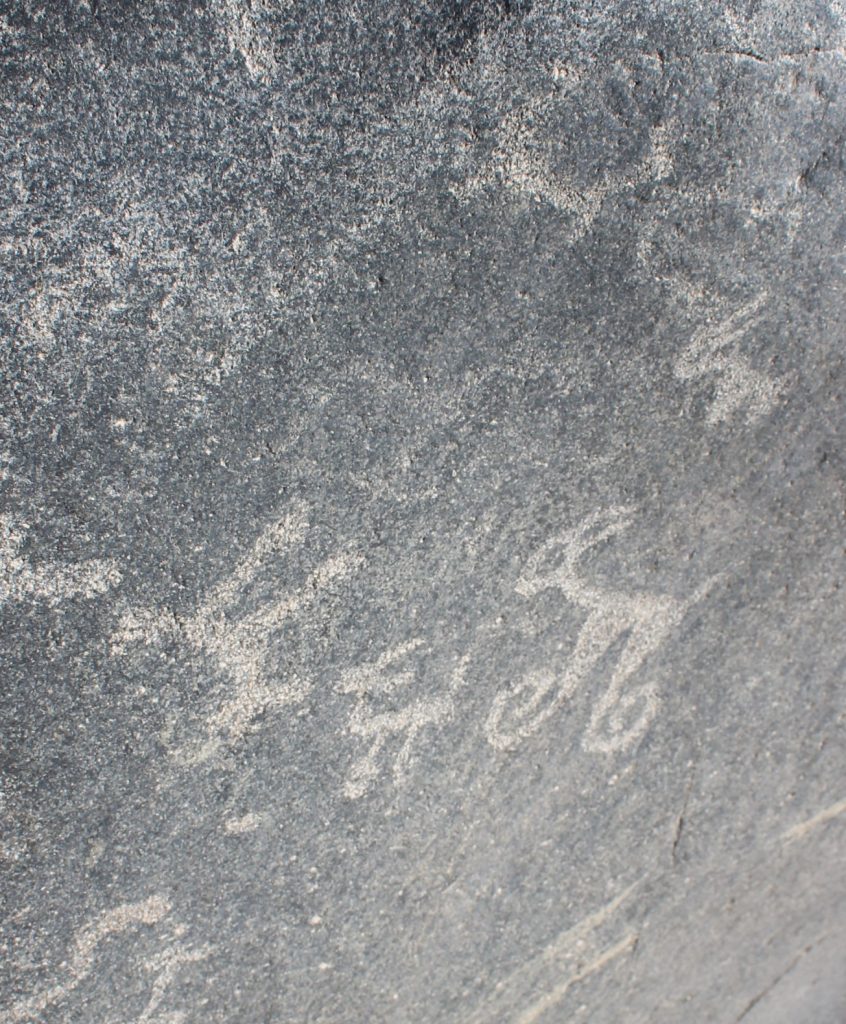Back in the hotel, I sit up reading into the early hours. The book Suyana has given me is a window into another world.
Some time around 1608, seventy-five years after the invasion, a catholic priest organised the collection and recording of myths and ritual practices. It appears to have been compiled by interviewing people of Huarochiri, occupying the heights to the west of Paria Caca and its cordillera, the highlands that source the waters of the Rimac, the Lurin, the Mala and the Cañete rivers.
The Huarochiri Manuscript describes the adventures of the gods, their brothers and sisters, their lovers and their children. Their activities are rooted in the landscapes and communities that existed before the spanish invasion. Water, water rights and water management are a constant theme.
“The native people of Cupara village survived just by channelling some water from a spring to their fields, and they were suffering greatly for lack of water at that time… They used to irrigate their fields by channelling the water downhill to fill some small reservoirs. In those days there was a native woman of that village named Chuqui Suso, a really beautiful woman. This woman was weeping while she irrigated her maize plants because they were drying out so badly, and because her water supply was so very scarce.”
Chuqui Suso persuades Paria Caca, the god who is personified in the form of a snow-capped twin peak mountain at the head of four valleys, to create a new irrigation canal. She then decides to remain at the head of the channel, turned into stone. She becomes the focus of religious celebration at the time of the annual canal cleaning and is a shrine and god in her own right.
The manuscript continues the story of Chuqui Suso after she has been transformed into a rock, a shrine and a goddess.
“In the old days, in the month of May when the canal had to be cleaned (as is done today, too), all these people went to the woman Chuqui Suso’s dwelling; they went with their maize beer, ticti, guinea pigs, and llamas to worship that demon woman … It is said that when they finished that, and accomplished everything else including their canal-cleaning, the people came home dancing and singing. They’d lead one woman along in their midst, reverencing her as they did the huaca and saying, “This is Chuqui Suso!” As this woman arrived at their village, we’d see some people awaiting her, laying out maize beer and other things and greeting her: “This is Chuqui Suso!” On that occasion they say people celebrated a major festival, dancing and drinking all night long.”
Canal cleaning is still important today, not just for practical reasons, but also as a focus for the local people, and often their visiting relatives, to gather and work together. It is carried out as an annual or semi-annual event, a community building and bonding exercise.
Throughout the Manuscript, however, we can also see how the spanish invasion and the religious repression that followed affected people.
“In fact that’s why, when the late lord Don Sebastián was still alive, during Corpus Christi and the other major Christian holy days, a woman used to proclaim, “I am Chuqui Suso!” and give maize beer from a large gold or silver jar with a large gourd to everyone in rank order, saying, “This is our mother’s beer!” Then she would also hand out toasted maize from a large hollow gourd … people from Huaro Cheri and from all the other communities used to go there. “They’ve cleaned Chuqui Suso’s canal. Come on, let’s go have a look!” they’d say… neither the alcalde [town mayor] nor anybody else would ever try to stop them …. On the contrary, they dance and drink right along with them until they get drunk. And as for the catholic priest, they fool him, saying, “Padre, I’m back from cleaning the canal, so I’m going to dance, I’m going to drink.”
The community was formed of different peoples with their own histories, rights, and privileges and rituals. There were times for ritual, managed by a yanca, who observed the passage of the sun with an aligned wall to determine the date. There were gifts and sacrifices of llamas and guinea pigs, coca leaves and ticti, sacred maize, to huacas, shrines, at these times, with dancing, chants and competitions.
The gods are born out of eggs on the mountain tops, they throw down lightning and hail fighting other gods, they release torrential floods “of yellow rain and red rain” to punish villages that do not respect them. And they remain in the landscape, often as stones and mountains. But all this was changing.
“But that one man who’d given Paria Caca a drink in Yaru Tini hung onto the tree as he’d been told, and was spared. When Paria Caca was finished sweeping everything away, he said to him, “Brother, now you’re alone by yourself. You must stay here forever. Later, when my children come to worship me from this spot, a quartet of guest huacsas [shrine attendants] will provide coca leaf for you to chew in perpetuity.”
““As for your name,” he added, “you shall be called Capac Huanca [lordly stone].” And he froze the man into stone. When Señor Doctor Avila came to the very spot where Capac Huanca dwelled, he in fact broke the huaca with some other people’s help. After he broke it, he heaved it downhill.”
It was amongst this Señor Doctor Avila’s papers that the Huarochiri Manuscript was rediscovered, over three hundred years later in Madrid, and translated from the Quechua by a German ethnologist in 1939. Doctor Avila was collecting the tales in the Manuscript to help him identify sacred places, huacas, in the landscape of the district, so that he could pillage their treasures and destroy their worship.
*********************************************************************************
The next morning we grab some coffee and a couple of rolls filled with fried egg in the market before take the bus upriver, alighting across the river from the stones. I have specific questions to answer, that have been in my mind since I first saw the stones months earlier. I started with a list of six symbols to investigate. I have made progress with the shaman, with tumis and tupus, and now with llamas. Two more to go. The masked figure and the fantastic birds.
But first of all, Suyana has some ideas to share.
We walk a little way downstream over the sand and river worn boulders and then follow a steep path up onto the terraces to emerge at the foot of the southernmost stone. Facing us are three images. To the right is what I call a fantastic bird, in the centre is a curious motif which could be a five-fingered hand, while on the left is a creature with an upraised tailed in a spiral over its back.
“This bird, clearly it is not a real bird, it is symbolic,” says Suyana. “The five triangles form a part of what we call the Chakana, or the Andean cross. Three steps up and three steps down. It represents the three levels of reality, the underworld, our daily world, and the world above.”
“But it has the head and body of a bird.”
“It is a bird and yet more than a bird. How many birds do you know that have spiral tails? It is a symbol in the form of a bird that represents a more fundamental aspect of reality, built on three levels.”
“Okay, I can see that. So what can you tell me about the hand?”
“Wait, there’s more. These three levels of reality can also be represented by the snake, the puma and the condor. At Christmas, churches throughout Peru display nativity scenes. They can be very elaborate. The baby Jesus is often attended by llamas and alpacas rather than shepherds and their sheep.”
“I have seen one of those in Cusco. It was an imaginary landscape that filled a whole room. And in addition to an ox and an ass, there were gorillas, tigers, elephants!”
“Yes, they are not depicting a stable in Bethlehem, but the whole cosmos. And, particularly in the Sierra, they will usually have an underworld and an overworld. Three levels of reality.”
“I have seen the three step motif on ceramics, and also on some adobe friezes at Maranga, at the zoo.”
“And then the spiral also represents the sea. It was very common in Wari imagery.”
“So this one image is saying several things?”
“It is a bird figure that represents the whole cosmos.”
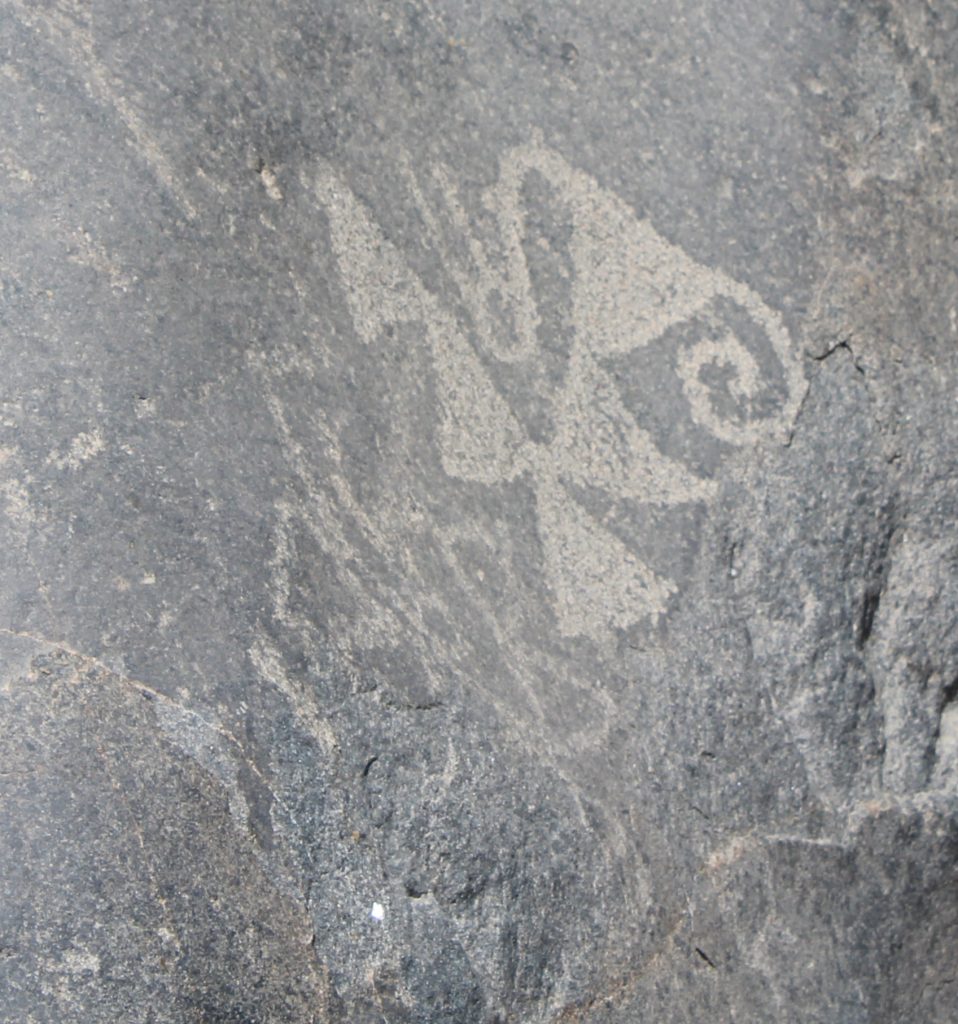
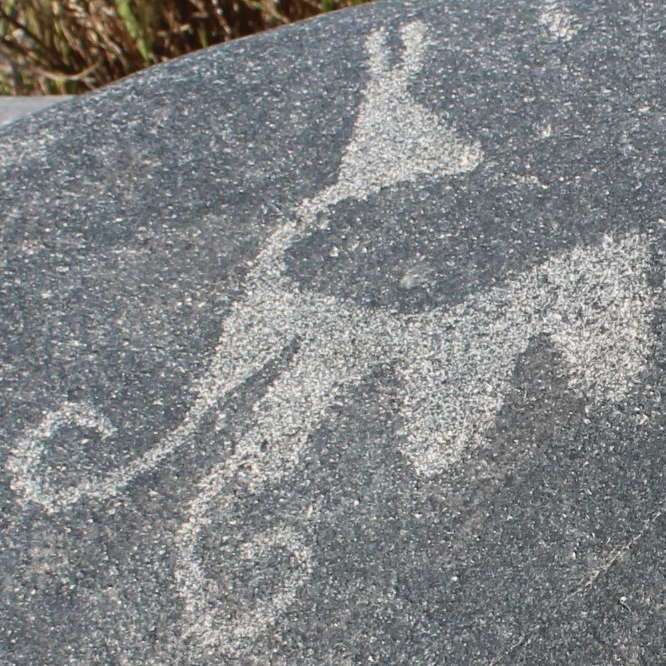
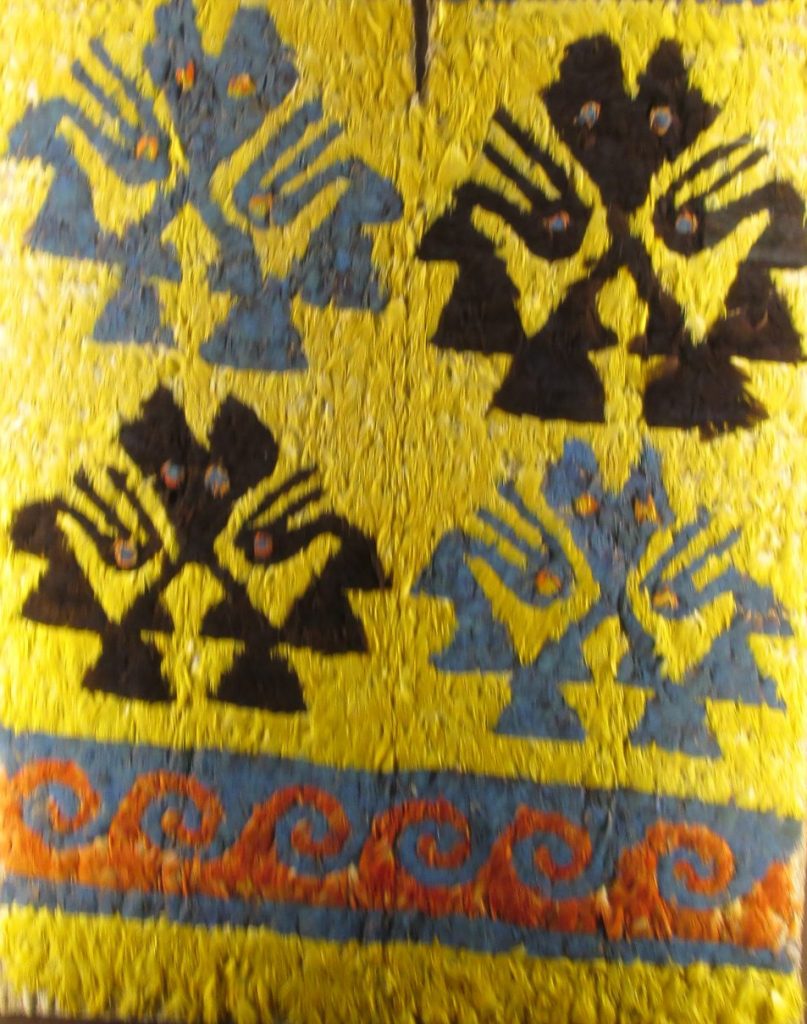
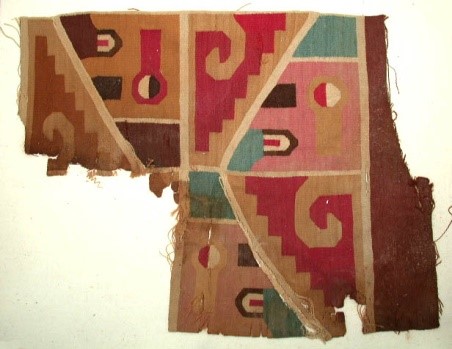
“So these people are not drawing a fantastic bird. They are expressing with symbols a rather complex concept of their reality. This is philosophy. And the idea is important enough to share.”
“That is it. As the Wari were a highland people who came to have great influence along the coast, perhaps they were using it symbolise their unifying power.”
“Do you think this shows Wari influence?”
“The symbol is much older than the Wari, and more widespread. The Moche and the Nazca used it, and even the Aztec and the Maya in Mexico. At the same time, the symbol is more recent, and looks very Chimu. “
Lots of Andean motifs have been recycled, and they may have had different meanings through time. But I have something else that will interest you. Did you notice that in places there are groups of symbols telling a story?”
“I don’t know what you mean,” I reply.
She shows me some photographs she took on her phone the previous day.
“In the first image there is another spiral bird. Note that above it is a simpler figure, clearly a bird, with two normal wings and a beak. Whilst below and to the left is a figure which looks more like a llama. The wings evolve into spirals and then into legs, whilst the beak becomes two ears. The llama is then repeated on the far left, but rotated.”
“Could these not just be different images drawn by different people?”
“They have similar brightness, and they are drawn on a panel facing the river that does not seem to have been used by earlier artists. In fact, I find it interesting that all three spiral birds are drawn on panels facing the river. Both the stones and the panels are marginal to the site. Whoever drew them, it seems to me, did not want to climb onto the upper terrace.”
“But if that does not convince you,” she continues, “the same pattern is repeated on another rock, this time much more faded.”
I look at the second image she shows me. “I see it. A llama at the top, evolving into a bird. And again, another llama, to one side, rotated.”
“Actually it is reflected and rotated. Such transformations arise naturally in weaving, and figures with double meanings are common – a feline that is also a fish. I wonder if it parallels the step and wave motif. Highlands and coast, llamas and sea birds.”
“I was reading the Huarochiri Manuscript last night. The conflict and also co-operation between the Checa, for example, and the Yunga, from the coast, was a frequent theme.”
“And this site, positioned between the two, may have been a place where they came together. So this motif that evolves from llama to seabird could represent something like “we are all one.” It is a big concept, written in stone. Which reminds me of the hand. It does not really look like a hand. Maybe a plant. But the five “fingers” might be significant.”
“Patterns of five kept turning up in the Manuscript,” I say. “Paria Caca was one of five brothers who were born out of five eggs. Chaupi Ñumca, Paria Caca’s wife, was one of five sisters. When the people celebrated, their festivities lasted for five days.”
“Exactamente. And the place where Paria Caca was born is called Cinco Cerros, five peaks. It is just 5 kilometres to the north of the Lurin valley, and it really is a remarkable mountain. Rising up in the heartlands of the Huarochiri region. An everyday reminder of their place of origin.”

“I have seen six or seven of these “feet” on three different rocks.” I pointed out.
“We can never be sure but my guess is that some are plants, and others, particularly those marked on the tops of panels, may represent Cinco Cerros, the birthplace of Paria Caca“.
“So you have told me what you think of the fantastic birds, and the five fingered hand, what about this creature with the spiral tail?”
“Well of course it is the spiral again,” Suyana replies. “Only spider monkeys have tails like that. Llamas have short tails. They can raise them, but they do not curve them over their backs. And its has a short neck, so it is not a llama or alpaca.”
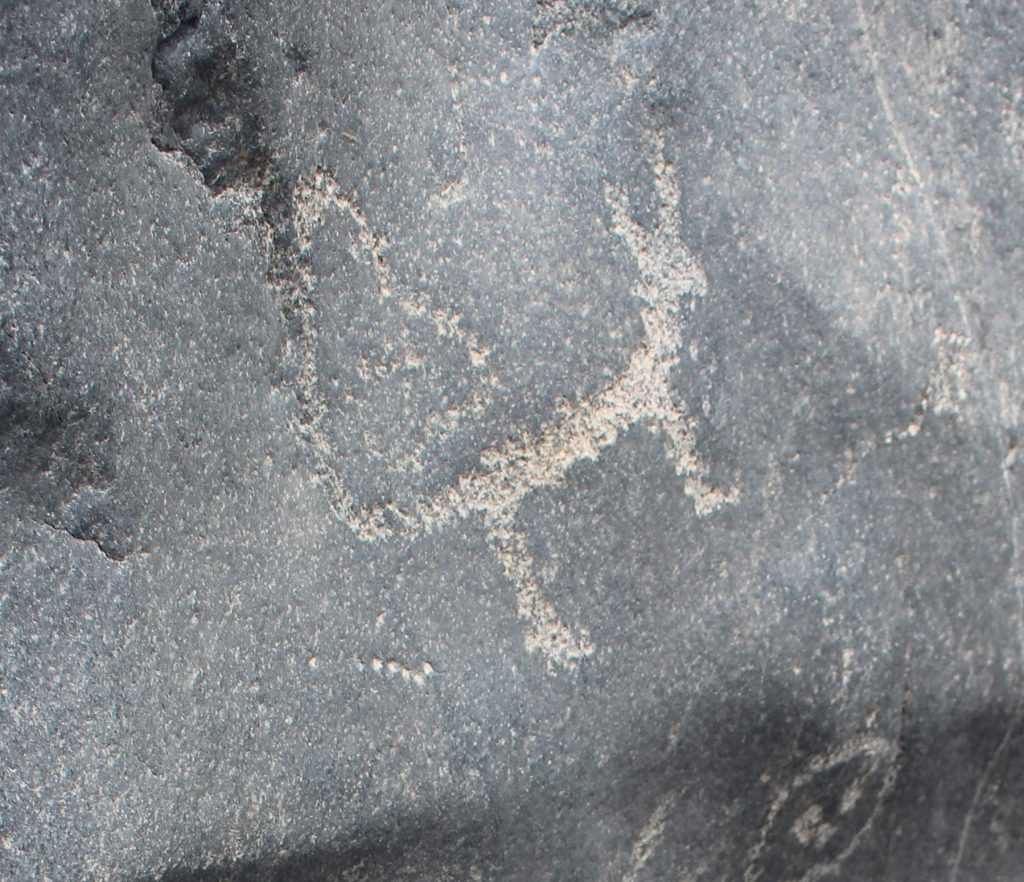
“I was wondering if they could be foxes. The fox was one of the sacred animals for Pachacamac.”
“But foxes have broad bushy tails, quite distinctive, and I don’t think they curl them over their back. But I know one special creature that does. The Peruvian hairless dog!”
I had seen these curious creatures padding softly around the ruins of the Huaca Pucclana in Miraflores. They are dark skinned and mostly hairless, though some have a Mohican peak of reddish hair on the top of the head. They do not bark, nor do they rush sycophantically towards any nearby humans. An altogether more mature animal than the household pets of Europe.

“These drawings are exaggerated,” Suyana continues, “but the perro sin pelo definitely have sickle tails. And I think you will find that it is a trait peculiar to hunting dogs. They would have hunted in packs, and the high tail helps them spread scent and be visible.”
“Or they could be felines, the Andean Cat or the Pampas Cat,” Suyana added. “But those animals like to turn their heads and direct both eyes at you, and they are normally depicted that way.”
“I’ll buy that. It interests me that this hunting dog or feline is drawn five times on this panel, and twice on another a little upstream. But nowhere else. These seven images are so similar, in style, brightness, position, that I can imagine that they were drawn by the same hand. Someone who approached this sacred space from across the river and added their icon to panels at the edge. As if they were afraid to trespass.”
“That is what I observed with the birds with the spiral tails. Late additions by someone who crossed the river but was afraid to climb up to the terrace. As if they were people with different gods, yet they respected and feared these stones.”
We continue walking around the site, and now I have a different perspective. Rather than looking for motifs like llamas or birds, I am looking for more abstract ideas. Spirals and steps of course, but I also see crosses in circles, parallel lines, patterns of dots.
“There seems to be just one spiral on every major rock, and they are mostly to the same design – three and a half turns of the circle,” I observe.
“And they are also often centrally positioned, and rather faded,” adds Sayuna. “That suggests they may be one of the earliest elements.”
In the less harsh light of August, the small boulder with the monkey, which I had first viewed as a seated shaman, displays a grouping of more than a dozen circles around dots. There are also figures which appeared to be menacing sea birds on the upper panel.
Other stones to the north have dots or circles with radial lines on their peak or skyward facing panels.
Two boulders at the northern, upriver end of the site have a repeated design of concentric circles, sometimes with a central dot, which we had not seen on the southern panels.
“One more thought that might interest you, though it comes from my experience around Juliaca,” says Suyana. “there is a harvest festival in early June, when they select particular crops, which they say are the gods of the crops. Two potatoes joined together they would call llallawi, or axomamas, and they would make of them an offering. Several images here look like llallawi to me. They were also called ispallas, or potatoes with two faces. There is an idea that they have been struck by lightning. Ispa is twin.”
“Why so many different names?”
“Different peoples, different languages. The British are the same. Swine is Old German and Dutch, hog is Celtic. Pork is from the Latin, pig is old English.”



The last boulder is ten metres long. It presents an almost flat surface facing the sky and a two metre drop towards the river. Beyond this we find a series of terraces descending to the river. There are traces of walls and patios here, and oval underground cysts, storage rooms or tombs, made of rounded river cobbles held together with dried clay.
Sitting here, on the edge of a platform ringed with fine white upright stones, I ask Suyana if she can explain to me something of the rituals she had seen in her travels.
“Travelling near Ayacucho, … I visited one house and the father had recently died. They had a funeral meal. We sat round the table and were served with plates of food. And then we watched and waited, until the cockroaches came to eat it….”
“That reminds me of something in the Manuscript, ” I reply, “where the people wait for flies to emerge from the corpses of their loved ones, and then they say to the fly, go now, you have no place here, do not come back.”
“What I saw was in the highest of the high lands, the Puna. Here we are in the middle valley, the Chaupi yunga. I know little about this.”
“But you travelled with a caravan in Colca, to the lowlands and then back to the highlands?”
“For people in the Colca valleys, their flow of water is a gift from the mountains. And so they talk to the mountains. Some people talk of pago. This is wrong. It is taught in Lima schools, but it is wrong. Pago. That is a spanish word. Payment. The spanish measured everything in gold and silver. Theirs was a brutal medieval world of slavery and poverty, domination or subjection. The world they found here was very different, and they destroyed it because they knew no better. That I understand. But why they are they still destroying it every day, when it is now their own country?”
“What was this pago?”
“The people do not offer the Apus pago, payment. They are talking to their gods, their ancestors, their family. They are not buying and selling. It is not a commercial arrangement.”
“By this misuse of language,” she continues, “the culture of the people, of the country itself, is diminished and distorted. To make it like spanish brutalism. It is not.”
“I think I understand. A friend explained this cultural confusion to me. The headmistress at his school considers herself to be passionately Peruvian. She wears the national team shirt in red and white when there is an international football match. And every day she paints her face in white powder and wears the highest heels. Her concept of national identity is of the colonial invaders.”
“As for the spanish, they are a sickness that will pass,” says Suyana, “but we are a long time waiting.”
“Back to the llamas,” I say. “The images on the stones do not appear to be representing llama caravans. After reading the Huarochiri manuscript, I am thinking that perhaps they represent llamas for sacrifice.”
“You may be right,” she replies, “but if you want to understand the symbolism of the llama caravans, I suggest you look at Choquequirao. “
**************************************************************************
10 November 2017. Keiko’s lawyer accuses the Editor of El Comercio of making false assertions “Odebrecht confirms that he financed Keiko’s campaign” and asks for a written correction within seven days – “Your timely rectification will contribute to a correct formation of public opinion” – whilst reserving the option of a civil suit for damages or a legal suit for wounding Keiko’s honour.
The newspaper replies “your letter asks us to rectify two allegations. That “Marcelo Odebrecht confirms that he financed the campaign of Senora Keiko Fujimori Higuchi” and that the same Odebrecht sustained that “I gave 500 thousand dollars to the Senora Keiko Fujimori Higuchi.”
“It would be difficult to rectify the second allegation since we did not make it. With regard to the first, we have said that Odebrecht confirmed that he “financed the campaign of Keiko” and specified that “you would have to check the details with Jorge Barata.”
“We have checked this affirmation and now we will make it again. Odebrecht said his business gave financial support to all the leading presidential candidates in 2011 and said that he noted in his diary the name of Keiko Fujimori with regard to support because be had a specific conversation about the matter with Senor Barata.”
***************************************
14 November 2017. Daniel Salaverry presents a formal Denuncia Constitutional against the Fiscal de la Nation, Pablo Sanchez, for “grave omission in the fight against corruption”. The Denunciation will be heard by the Congressional Sub-commission on Constitutional Accusations. The 15 members of the sub-commission include 8 party members of the FP, plus the President who is FP congressista Milagros Takayama.
The denunciation came a week after Salaverry had objected to the decision of the Fiscal to reopen the case againgst the leader of Fuerza Popular, Keiko Fujimori, daughter of the disgraced dictator Alberto Fujimori, for organized crime. And said “some Fiscals seem to be the political operators of anti Fujimorismo”.
If the Denunciation is accepted by the Subcomission, the Congress can remove the Fiscal from his post by a majority vote. Salaverry, who is the spokesman for the Fuerza Popular, said the Denunciation was a personal initiative and he would inform his party about it at their next meeting.

